
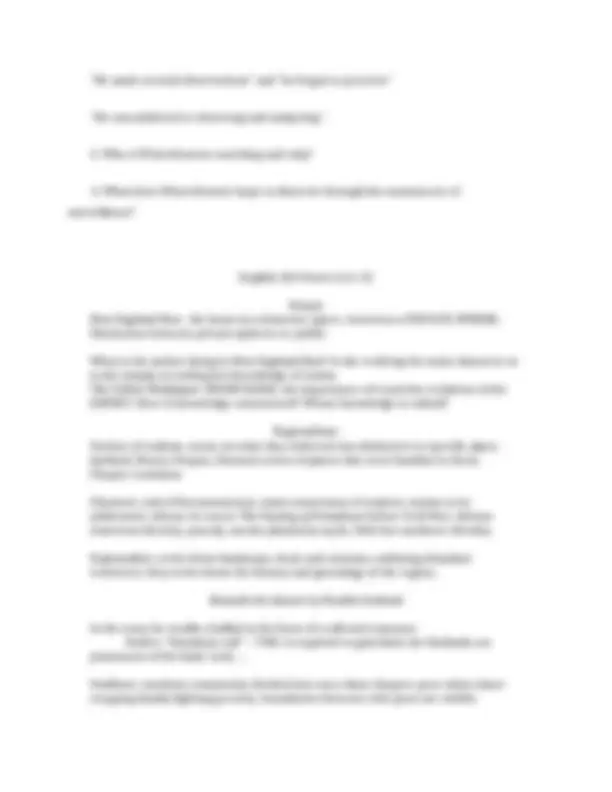
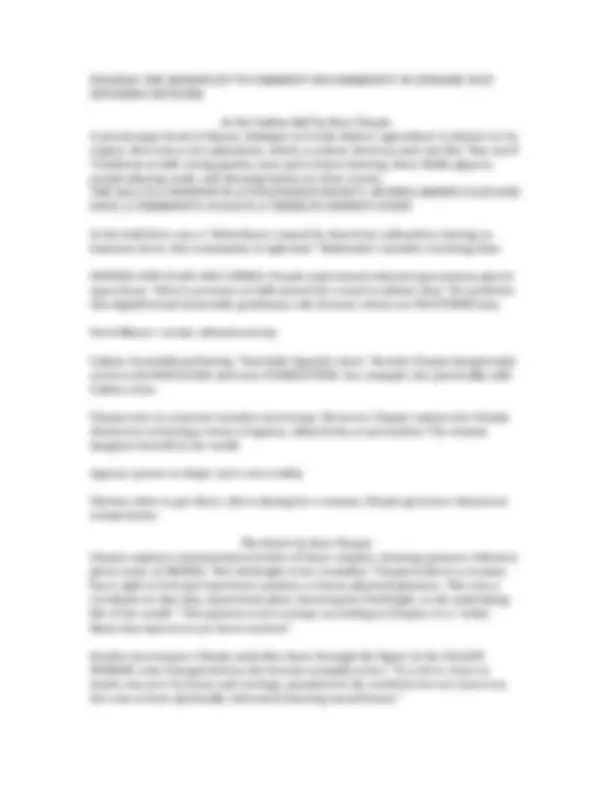
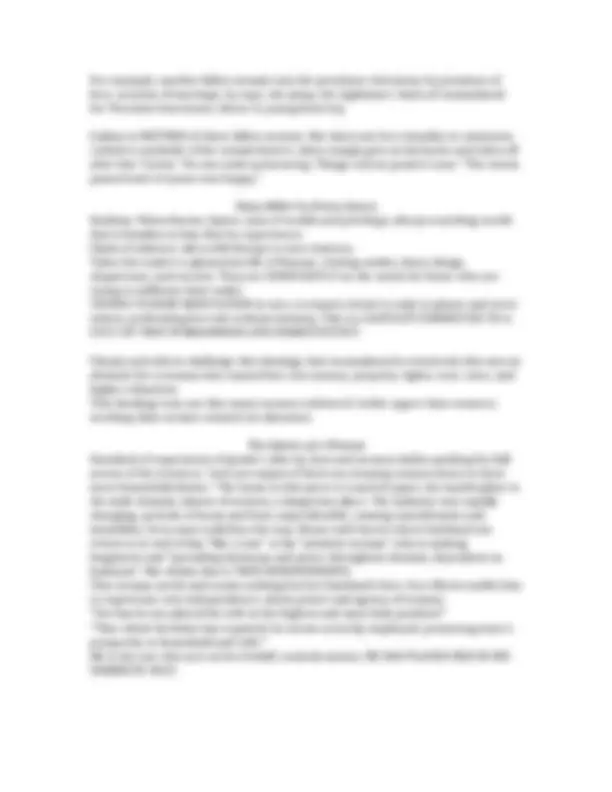
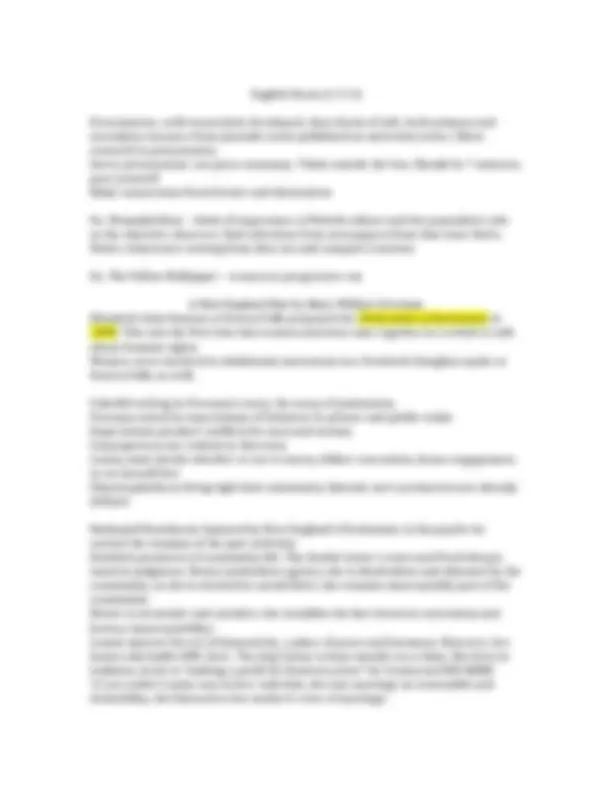
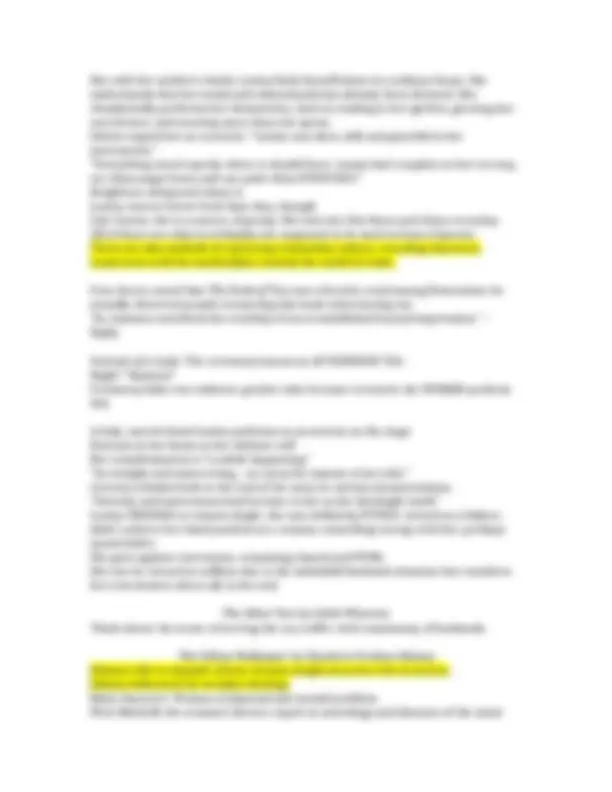
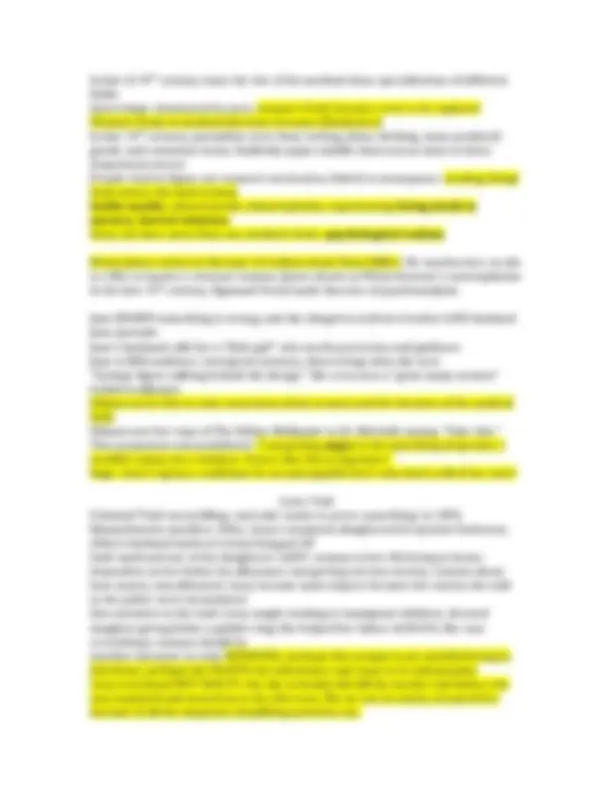
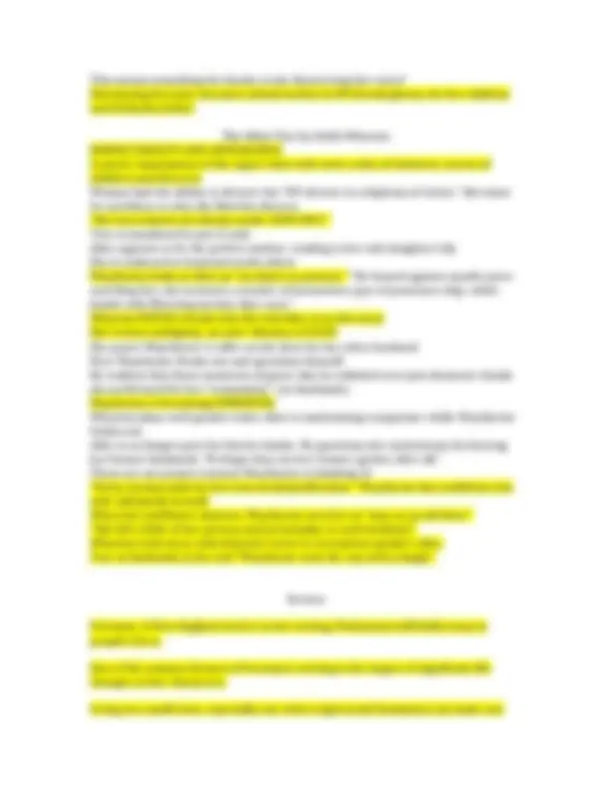
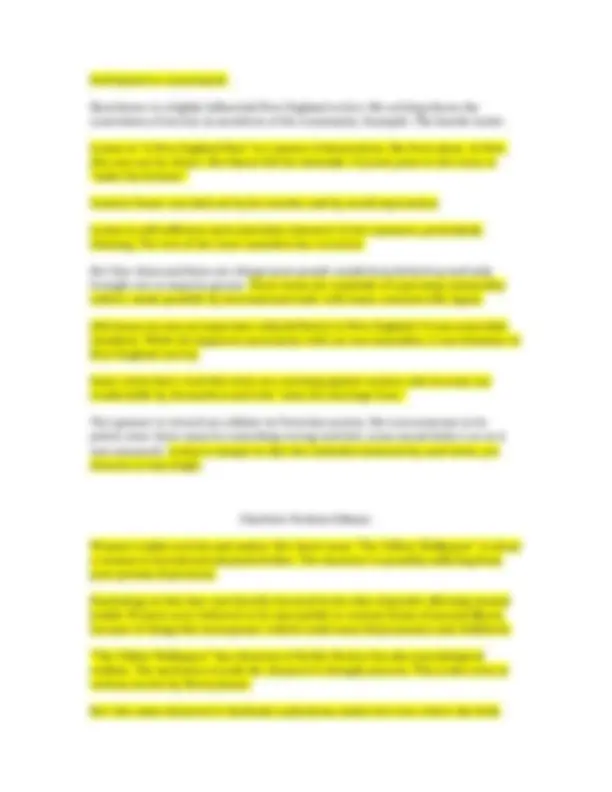
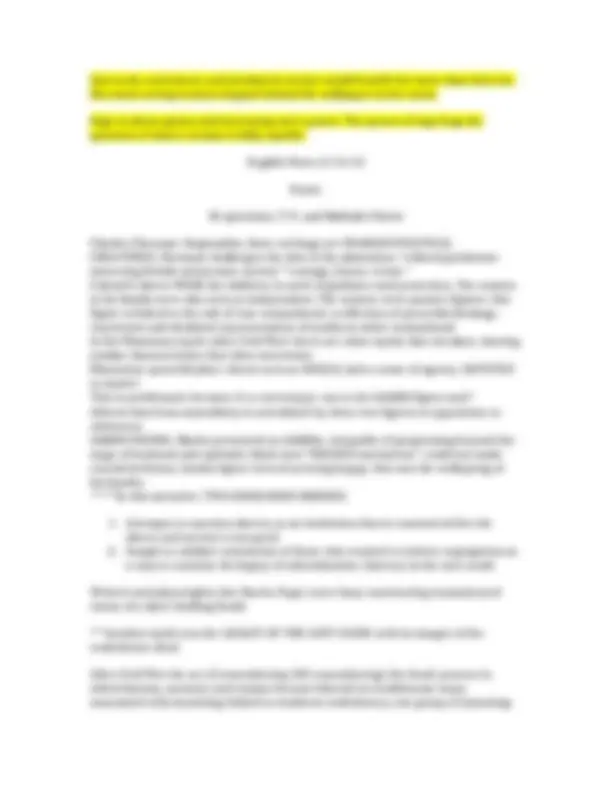
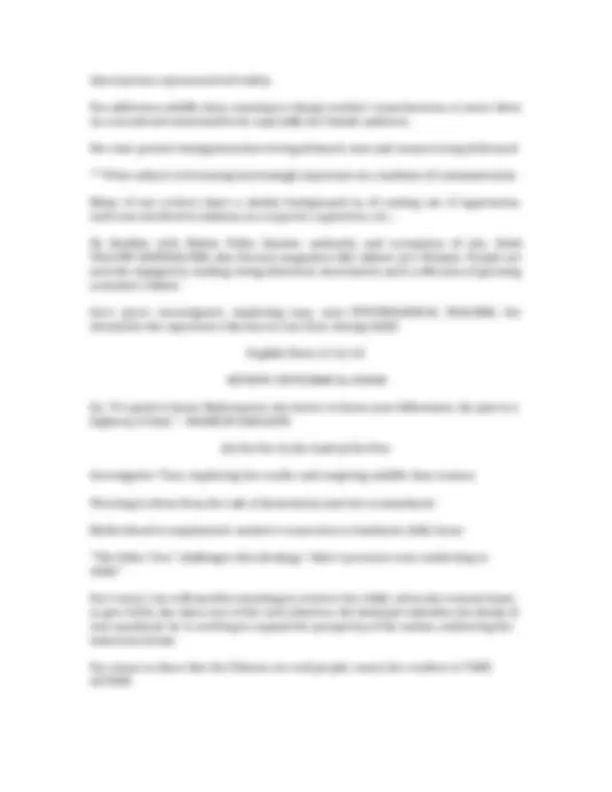
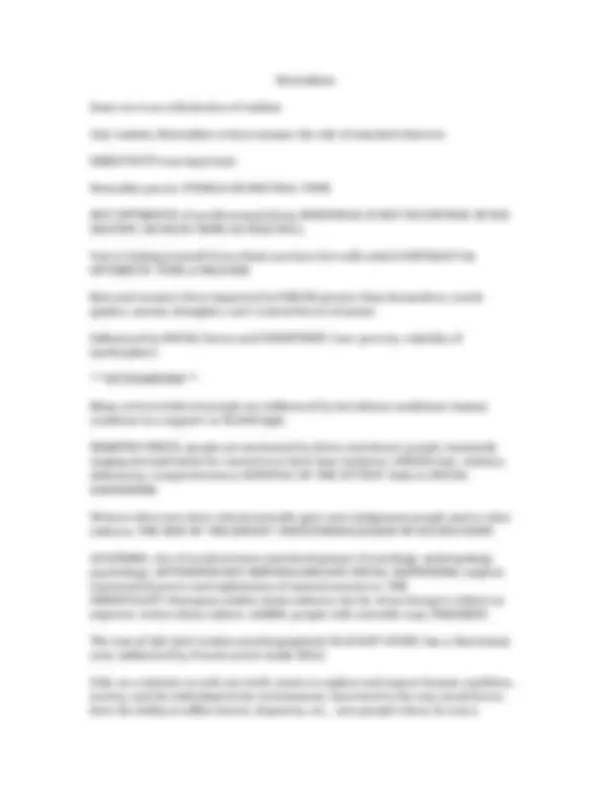
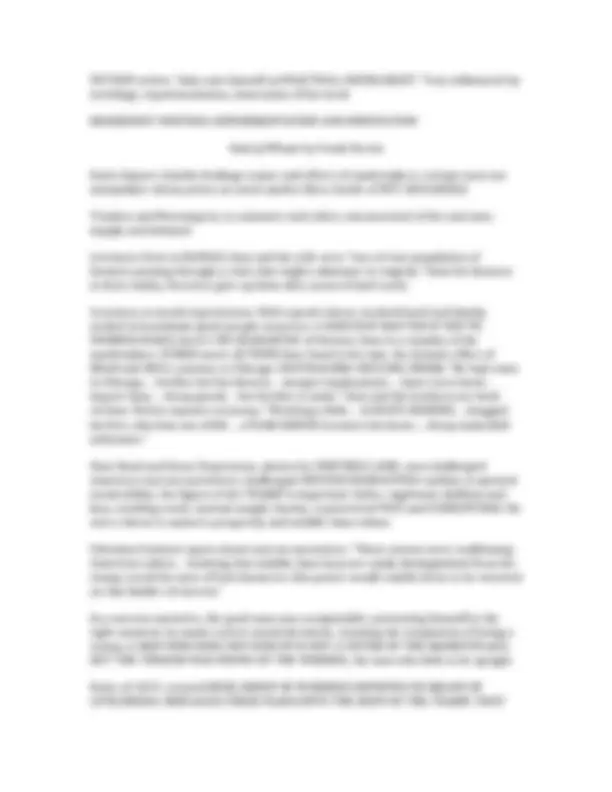
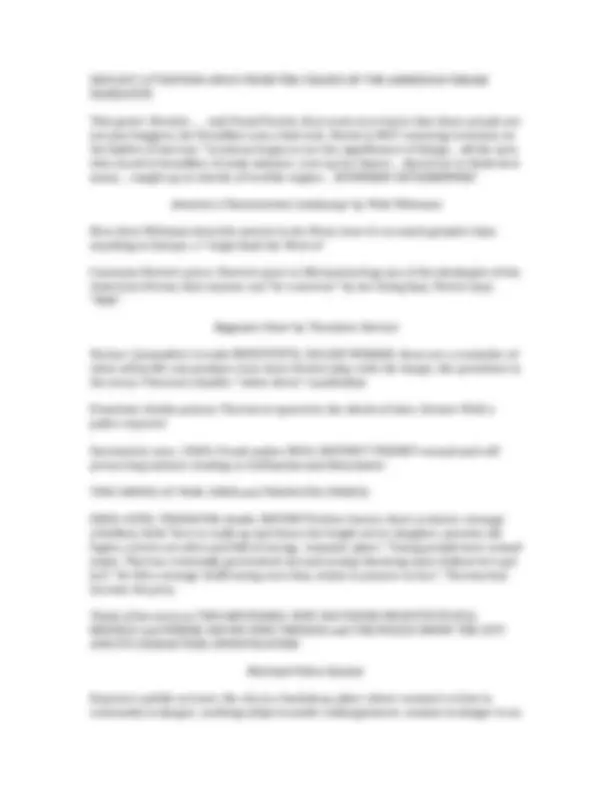



Study with the several resources on Docsity

Earn points by helping other students or get them with a premium plan


Prepare for your exams
Study with the several resources on Docsity

Earn points to download
Earn points by helping other students or get them with a premium plan
Community
Ask the community for help and clear up your study doubts
Discover the best universities in your country according to Docsity users
Free resources
Download our free guides on studying techniques, anxiety management strategies, and thesis advice from Docsity tutors
Midterm notes Material Type: Notes; Professor: Starkey; Class: Survey of American Lit since Civil War; Subject: English; University: University of Mississippi Main Campus;
Typology: Study notes
1 / 22

This page cannot be seen from the preview
Don't miss anything!















English Notes on Realism
to make a life altering choice, a moral or ethical decision. Think of Mark Twain’s reflection on his time spent as a Marion Ranger, how killing a man impacted him.
At the Cadian Ball by Kate Chopin A picturesque local LA Bayou; dialogue in Creole dialect; agriculture is distinct to its region: Alcee has a rice plantation, which a cyclone destroys and cuts like “fine steel” Traditions at ball: eating gumbo, men and women dancing, three fiddle players, people playing cards, and sleeping babies in other rooms. THE BALL IS A WINDOW IN A STRATIGIZED SOCIETY, DIVIDED AMONG CLASS AND RACE; A COMMUNITY; PLACE IS A THEME IN CHOPIN’S STORY At the ball there was a “disturbance caused by American railroaders, having no business there; this community is tight-knit” Railroader=outsider/working class GENDER AND CLASS ARE LINKED: People understand cultural expectations placed upon them. “Alcee’s presence at ball caused the crowd to admire him.” He performs this dignified and honorable gentleman role because others are WATCHING him. Surveillance= social, cultural activity Calixta: beautiful and luring: “that little Spanish vixen.” Rowdy; Chopin dangerously writes with NOSTALGIA and uses STEREOTYPES. For example, she practically calls Calixta a hoe. Chopin tries to construct another stereotype. However, Chopin endows her female characters as having a sense of agency, subjectivity or perception. The woman imagines herself in the world Agency=power to shape one’s own reality Clarisse rides to get Alcee; this is daring for a woman; Chopin gives her characters sexual desire. The Storm by Kate Chopin Chopin explores extramarital activities of these couples; cheating spouses; Calixta is given sense of DESIRE; “Her birthright is her sexuality.” Chopin believes a woman has a right to feel and experience passion, to know physical pleasure; “She was a revelation in that dim, mysterious place, knowing her birthright, to the underlying life of the world.” This passion is not corrupt, according to Chopin; it’s a “white flame that had never yet been reached.” Gender stereotypes: Chopin underlies them through the figure of the FALLEN WOMAN, who transgressed as she became sexually active; “To a fever, froze to death, run over by horse and carriage, punished in the world for her act; however, she was at least spiritually redeemed, learning moral lesson.”
For example, another fallen woman was the prostitute, led astray by promises of love, security of marriage, by rape, the pimp, the nightmare vision of womanhood for Victorian Americans; threat to young farm boy Calixta is NEITHER of these fallen women: She discovers her sexuality in rainstorm (which is symbolic of her sexual desire); Alcee simply gets on his horse and rides off after this “storm.” No one ends up knowing. Things end on positive note: “The storm passed and everyone was happy.” Daisy Miller by Henry James Realism: Winterborne: James: man of wealth and privilege; always watching world that is familiar to him that he experiences Clash of cultures: old world Europe to new America Takes his reader to glamorous life of Europe, visiting castles, fancy things, chaperones, and escorts. They are CONSTANTLY on the watch for those who are trying to infiltrate their ranks. TRYING TO KEEP REPUTATION in tact, a woman’s desire is only to please and serve others, performing her role without misstep. This is a FANTASY CONNECTED TO A CULT OF TRUE WOMANHOOD AND DOMESTICITICY. Chopin and others challenge this ideology that womanhood is restricted; this was an obstacle for a woman who wanted her own money, property rights, vote, voice, and higher education. This ideology was one that many women embraced (white upper class women); working class women wanted an education. The Sphere of a Woman Standard of expectation of gender roles by men and women; ladies pushing for full access of the sciences; “men are unjust of their sex, keeping women down to their mere household duties.” The home in this piece is a sacred space; the marketplace is the male domain, absent of women, a dangerous place. The industry was rapidly changing, periods of boom and bust, unpredictable, causing unsettlement and instability. Even man could lose his way. Home=safe haven where husband can return to at end of day “like a star” to his “prudent woman” who is making happiness and “spreading harmony and peace throughout domain, dependent on husband.” She thinks this is TRUE INDEPENDENCE. This woman needs and wants nothing but her husband’s love; her efforts enable him to experience true independence; about power and agency of woman. “For has he not placed his wife in the highest and most holy position?” “That which his labor has required, he seems securely employed, promoting state’s prosperity to household and wife.” HE is the one who acts on her behalf, controls money. HE HAS PLACED HER IN HIS DOMESTIC SEAT.
English Notes 2/7/ Presentation: well-researched, developed, clear thesis of info, both primary and secondary resource from journals (texts published on university texts.) Show research in presentation. Savvy presentation: not just a summary. Think outside the box. Should be 7 minutes; pace yourself Make connections from lecture and discussions Ex. Wounded Knee – think of importance of British culture and the journalist’s role as the objective observer; find selections from newspapers from that time; find a Native American’s writing from then too and compare/contrast Ex. The Yellow Wallpaper – women in progressive era A New England Nun by Mary Wilkins Freeman Elizabeth Cady Stanton at Seneca Falls proposed the Declaration of Sentiments in
In late of 19th^ century came the rise of the medical class; specialization of different fields Gynecology: dominated by men; woman’s body became a text to be explored Woman’s body in medical discourse became ditholosized In late 19th^ century, journalists were busy writing about clothing, mass produced goods, and consumer items; Suddenly upper middle class was an issue in these department stores People tried to figure out women’s motivation; linked to menopause; stealing things from stores: the mad woman Gothic motifs, colonel motifs, claustrophobia, experiencing living death in nursery, barred windows Story can have more than one aesthetic form: psychological realism Henry James writes in this type of realism about Daisy Miller; He watches her, as she is a flirt or maybe a virtuous woman; James shows us Winterbourne’s contemplation In the late 19th^ century, Sigmund Freud made theories of psychoanalysis. Jane KNOWS something is wrong, and she disagrees with her brother AND husband Jane journals Jane’s husband calls her a “little girl” who needs protection and guidance Jane is HER audience, tracing her journey, discovering what she sees. “Strange figure sulking behind the design.” She even sees a “great many women” behind wallpaper. Gilman wrote this to raise awareness about women and the theories of the medical field. Gilman sent her copy of The Yellow Wallpaper to Dr. Mitchell, saying, “Take this.” This promotion was prohibited: “I am getting angry to do something desperate; I wouldn’t jump out a window; I know that this is improper.” Rage= Jane’s agency; could Jane be an unstoppable force who had a will of her own? Lizzy Trial Criminal Trial=storytelling; each side wants to prove something; in 1892, Massachusetts murders: Abby: Lizzy’s stepmom slaughtered in upstairs bedroom; Abby’s husband Andrew’s head chopped off Irish maid and one of the daughters: LIZZY: woman in her 30s living at home; dependent on her father for allowance and getting out into society; tension about how money was allocated; Lizzy became main suspect because her stories she told to the police were inconsistent One narrative in the trial: Lizzy taught reading to immigrant children; devoted daughter giving father a golden ring; She helped her father ALWAYS; She was everything a woman should be Another narrative in trial: HOWEVER, perhaps this woman is not satisfied living in this home; perhaps she WANTS the inheritance and want to be independent Lizzy was found NOT GUILTY; but she seriously did kill the mother and father; she was acquitted and moved up to the elite area. But no one in society accepted her because of all the suspicion; shoplifting activities too.
English 2/9/
This means something for Sarah; is she discovering her voice? Outrunning her past, becomes school teacher in NY Jewish ghetto; for her children and Orthodox father The Other Two by Edith Wharton RESPECTABILITY AND APPEARANCE A satiric examination of the upper class with strict codes of behavior; access of children and divorces Woman had the ability to divorce but “NY divorce is a diploma of virtue.” She must be careful as to why she filed the divorce “Her movements are always under SCRUTINY.” True womanhood is put to task. Alice appears to be the perfect mother, tending to her sick daughter Lily She is endowed to heal and sooth others Waythorne looks at Alice as “an object to possess.” “He leaned against mantle piece watching her; she seemed a creature of harmonies; joys of possessor ship; white hands with flittering motion; lips; eyes.” Wharton NEVER reveals who the real Alice is in this story She creates ambiguity, as ones’ identity is FLUID She pours Waythorne’s coffee as she does for her other husband Now Waythorne freaks out and questions himself He realizes that those moments of grace that he relished were just domestic rituals she performed for her “community” (ex-husbands) Waythorne is becoming UNNERVED Wharton plays with gender roles; Alice is maintaining composure while Waythorne freaks out. Alice is no longer pure for him he thinks. He questions her motivations for leaving her former husbands. “Perhaps they weren’t brutes (gerks) after all.” These are not proper reasons Waythorne is thinking of. “Every woman must be her own social justification.” Waythorne has confidence his wife will justify herself. When his confidence shatters, Waythorne sees her as “easy as an old shoe.” “She left a little of her privacy and personality to each husband.” Wharton ends story with domestic scene to reconstruct gender roles. Two ex husbands at the end “Waythorne took the cup with a laugh.” Review Freeman: A New England writer; in her writing, Puritanism still holds sway in people’s lives. One of the primary themes of Freeman’s writing is the impact of significant life changes on her characters. Living in a small town, especially one with a rigid social foundation can make one
feel limited or constrained. Hawthorne is a highly influential New England writer. His writing shows the constraints of society on members of the community. Example: The Scarlet Letter. Louisa in “A New England Nun” is a master of domesticity. She lives alone. At first, this was not by choice. Her fiancé left for Australia 14 years prior to the story to “make his fortune.” Louisa’s future was laid out by her mother and by social expectation. Louisa is self-sufficient and somewhat obsessive in her manners, particularly cleaning. The rest of the town considers her eccentric. Her fine china and linen are things most people would keep locked up and only brought out to impress guests. These items are symbolic of a growing commodity culture, made possible by international trade with Asian countries like Japan. Afternoon tea was an important cultural fixture in New England. It was somewhat ritualistic. While the Japanese association with tea was masculine, it was feminine in New England society. Some critics have read this story as a warning against women who become too comfortable by themselves and who “miss the marriage boat.” The spinster is viewed as a failure in Victorian society. She was someone to be pitied, since there must be something wrong with her, some moral defect (or so it was assumed). Louisa is unique in that she embodies domesticity and virtue, yet chooses to stay single. Charlotte Perkins Gilman: Woman’s rights activist and author. Her short story “The Yellow Wallpaper” is about a woman in mental and physical decline. The character is possibly suffering from post-partum depression. Psychology at this time was heavily invested in the idea of gender affecting mental health. Women were believed to be susceptible to various forms of mental illness because of things like menopause (which could cause kleptomania) and childbirth. “The Yellow Wallpaper” has elements of Gothic fiction, but also psychological realism. The narration reveals the character’s thought process. This is also seen in various stories by Henry James. Her (the main character’s) husband, a physician, makes her rest, where she feels
was the United Daughters of Confederacy who pushed for local and state government to make public sights of memory (Ex: Stone Mountain) ; white middle class southern women; they wanted to indoctrinate their version of history ***PUBLIC SITE=CHARGED SPACE where HISTORY AND MEMORY BECOME FUSED; a memorial’s meaning is dependent on the spectator This is linked to the act of nation building; memorials connect or disconnect what is being presented Fitzgerald’s Ice Palace : South exists in a twilight memory that is disconnected from her fiancé ***Chessnut destabilizes stereotypes and false views of the plantation; he wanted to expose the history of slavery in which men and women were treated as commodities, in attempt to sanitize history At the start of the story we see Dick Owens; his life is the life of procrastination, made possible by the labor of others because he sees himself in a HEIRARCHAL position of others Different scholars can use philosophy to examine the ways to explore mentality of slave-holding aristocracy Ex: Hagel: Femininology of the Spirit he explores consciousness, self-consciousness, and knowledge; doing this in a historical and cultural context, tracing the battle for recognition and humanity’s slow evolution toward a collective or true consciousness (or what Hagel would describe as spirit) Hagel explores where the “I” disappears and is replaced by the “we.” THE MASTER DEPENDS ON HIS DOMINATION OF THE SLAVE TO FORM HIS OWN SENSE OF SELFHOOD OR NOTION OF “I” This construction of self, as Hagel sees, is a FALSE REALITY; in his desire to control slaves, he fails to the slaves as human (lack of recognition) a SUBJECT ENDOWED WITH “I.” Being “I”: process of forming “WE.” Dick Owen and Colonel only see the slaves as object or prize There is a dependency in the relationship described; only through the labor of the slaves Master is truly DEPENDENT on the slave for his sense of self; the slave’s consciousness is fully evolved, even though he is in bondage; his consciousness is independent of the master
Dick Owens wants to win the heart of Charity; not sincere motions; just wants to show Charity how great he is. He wants to be seen as morally upright to his sweetheart; Chessnut’s actions are comical, false actions Chessnut parodies southern manhood; plays with stereotype; just like the Colonel; However the Colonel just wants to maintain his status in the community and in the eyes of fellow slaveholders; he wants to possess Grandison because these slaves are “essential to identity construction… dependent on them for labor and false consciousness… project on the bodies of his subjegative slaves.” – Hagel Grandison is “abolitionist-proof” according to Colonel Here Chessnut is another move of slaveholding mentality; Colonel warns Grandison about the “enticing” abolitionists who take you away from the beautiful south; the north he describes as a place of former slaves who get sick and starve and are unloved – Colonel Colonel’s tale of the North is actually the definition of SLAVERY. All that stuff he says is only true in the South where he is; it’s an IRONIC NARRATIVE PLAY ON BEHALF OF THE AUTHOR Chessnut exposes false consciousness of slaveholder; a mentality that denies the true reality of the plantation life When Colonel gives Grandison a day off or lets him get married, each situation reveals the colonel’s control over Grandison; each of these acts requires permission; Grandison: Chessnut weaves a narrative tale resistance Grandison is the loyal slave; he never takes the bait Grandison has the sense of agency, interiority independent from the master Colonel Owens. Grandison has been making plans of his own all along, having the desire to FREE HIS FAMILY, turning the tables on the idea that the slave has other desires besides maintaining plantation In the Land of the Free by Sui Sin Far Raise awareness about the troubles that foreigners experience prejudice Chinatown was mysterious and scary to so many Chinese Exclusion Act: Far tackles this in her story ***The title is ironic commentary on ideals America represented on the symbols
Naturalism: Some see it as a distinction of realism Like realists, Naturalists writers assume the role of attached observer OBJECTIVITY was important Naturalist pieces: STERILE OR NEUTRAL TONE NOT OPTIMISTIC of world around them; INDIVIDUAL IS NOT IN CONTROL OF HIS DESTINY; NO SUCH THING AS FREE WILL You’re fooling yourself if you think you have free will, which CONTRAST the OPTIMISTIC TONE of REALISM Men and women’s lives impacted by FORCES greater than themselves; (earth quakes, storms, droughts); can’t control forces of nature Influenced by SOCIAL forces and CONDITIONS (war, poverty, volatility of marketplace) DETERMINISM Many writers believed people are influenced by hereditary conditions; human condition in a negative or BLEAK light. SIGMUND FREUD: people are motivated by drives and desire; people constantly waging internal battle for control over their base instincts; (GREED, lust, violence, dishonesty, competitiveness) SURVIVAL OF THE FITTEST: links to SOCIAL DARWINISM Writers often turn their critical scientific gaze onto indigenous people and to other cultures. THE RISE OF THE EXPERT: PROFESSIONALIZAION OF OCCUPATIONS ACADEMIA: rise of social sciences and development of sociology, anthropology, psychology; ANTHROPOLOGY=IMPERIALISM AND SOCIAL DARWINISM; empires represented power and exploitation of natural resources; THE ORIENTALIST=European studies Asian cultures, but he views Europe’s culture as superior; writes about culture, wildlife, people with scientific way; PROGRESS The Law of Life : Jack London autobiographical; BLATANT STORY; has a Darwinism tone; influenced by French writer Amile ZOLA Zola: on a mission to seek out truth; wants to explore and expose human condition, society, and the individual in his environment; interested in the way social forces have the ability to afflict horror, depravity, etc… into people’s lives; he was a
FICTION writer; “Also saw himself as PRACTICAL SOCIOLOGIST.” Very influenced by sociology, experimentation, innovation of his work MODERNIST WRITERS: EXPERIMENTATION AND INNOVATION Deal of Wheat by Frank Norris Each chapter: double dealings (cause and effect) of marketplace; corrupt men can manipulate wheat prices on stock market floor; battle of WIT AND GREED Truslow and Hornung try to outsmart each other, unconcerned of the outcome; supply and demand Lewiston: lives in KANSAS; Sam and his wife were “two of vast population of farmers passing through a crisis that might culminate in tragedy.” Ruin for farmers is their reality; forced to give up farm after years of hard work. Lewiston, in social expectations, WAS a good citizen; worked hard, had family, settled in heartland; good people; however, it DOES NOT MATTER IF YOU’VE WORKED HARD; there’s NO GUARANTEE of fortune; Sam is a casualty of the marketplace; OTHER men’s ACTIONS have lead to his ruin; the domino effect of BEAR and BULL; journey to Chicago; NATURALISM=DECLINE/DOOM: “He had come to Chicago… brother Joe hat factory… meager employment… times were hard… import duty… cheap goods… his brother is aside.” Sam and his brothers are both victims: Norris exposes economy: “Working a little… ALWAYS SEEKING… dragged his feet, shut him out of life… a PARK BENCH becomes his home… cheap makeshift substance.” Dust Bowl and Great Depression: photos by DORTHEA LANE; men challenged America’s success narratives; challenged SUCCESS NARRATIVES=outline to upward social ability; the figure of the TRAMP is important (hobo, vagabond, shiftless and lazy, avoiding work, instead sought charity; represented VICE and CORRUPTION) He was a threat to nation’s prosperity and middle-class values Christina Fatinas’s quote about success narratives: “These stories were reaffirming American values… insisting that middle class boys are easily distinguished from the tramp; avoid the men of bad character; this power would enable them to be restored on that ladder of success.” In a success narrative, the good man was recognizable; presenting himself at the right moment; he made correct moral decisions, resisting the temptation of being a tramp; A MAN WHO DOES NOT RISE UP IS NOT A VICTIM OF THE MARKETPLACE, BUT THE THOUGH WAS FOUND OF THE WORKER; the man who fails to be upright Panic of 1873: created HUGE GROUP OF WORKERS DEPRIVED OF MEANS OF LIVELIHOOD; DISPLACED THEIR FEARS ONTO THE BODY OF THE TRAMP; THEY